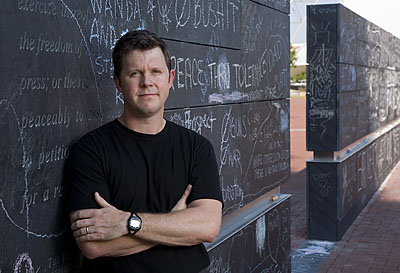Handwriting on the Wall
Peter O’Shea ’88 is not afraid to speak his mind, whether that means stopping to chat with everyone on his three-block walk home for lunch, or telling off some teenagers kicking ornaments off a city Christmas tree. Your community, after all, is what you make it.

Landscape architect Peter O’Shea ’88 leans against the Community Chalkboard and Podium that he helped to bring to Charlottesville, Va. Photograph by Tom Cogill.
So it seems apt that when O’Shea and his friend Robert Winstead, an architect, brainstormed ideas for a First Amendment monument design competition in Charlottesville, Va., where they both live and work, they brought a similar attitude to a dinnertime discussion in Winstead’s apartment: The citizens should have their say.
“We thought everyone else’s concepts would be high-tech with fancy lights and touch screens,” says O’Shea. “We focused instead on what a First Amendment monument should do on the most fundamental level, and we decided that that was simply to encourage people to talk.”
They used a children’s chalkboard from Kmart to craft a scale model of their concept: a large public chalkboard. And that’s what they entered in the design competition for the monument, sponsored by the Thomas Jefferson Center for the Protection of Free Expression in Charlottesville.
“We thought the committee would hate it, that they’d be afraid of what people might write on a public chalkboard,” says O’Shea, co-founder of Siteworks, a Charlottesville firm offering landscape architecture, urban design, master planning and garden design. “But we wanted the monument — in its simplicity and minimalism — to be sort of confrontational, not cozy or comfy. The key would be what people would do with it.” Far from hate it, the committee embraced O’Shea and Winstead’s design, unanimously choosing it from more than 35 entries.
This was back in 1998, when it took about three hours for O’Shea and Winstead, now director of sustainable design for VMDO Architects, to dream up their idea on the eve of the competition deadline. By the time the actual monument appeared, in spring 2006, the friends’ dinner gatherings had grown to include wives and children. Indeed, the free-speech monument didn’t appear overnight in front of Charlottesville’s City Hall like the monolith in A Space Odyssey.
First, the city had to give its approval, and there’s nothing like a proposed free-speech monument to bring out a lot of free speech. One early City Council meeting to discuss the project, in late 2000, drew an SRO crowd. Jammed into that meeting hall were politicians and parents, business owners and students, Republicans, Democrats, and libertarians. Some vehemently opposed the proposed monument. What if their children walked by it and saw swastikas or racial slurs? Others thought the idea was inspired — a public place for every individual to express ideas uncensored.
“One high school student said that she had recently won a poetry contest but wasn’t allowed to hang her poem in school because it had ‘violent imagery,’” says O’Shea. On the proposed community chalkboard, the girl had asserted, she’d be able to write her poem; she’d have a place to express herself honestly, to let her words take flight.
The city approved the project in March 2001. Mayor Blake Caravati, called an “idiot” by some for supporting the project, said that it would “reaffirm something we’ve lost in this country…respect for the public realm.”
After approval, O’Shea and Winstead mostly waited on the sidelines as the Jefferson Center raised money ($250,000) and the city finalized plans to redevelop the site. But occasionally, the pair entered the fray. “A consultant for the city suggested moving the monument off to the side,” says O’Shea. “We fought that, and we won. We feel the monument should be in dialogue with the front door of City Hall.”
Dedicated last May, the chalkboard consists of two 7-foot-high tablets of local Buckingham County slate, one 50 feet long and the other 12 feet long, mounted on concrete. At first, O’Shea admits he was “nervous” about his role in creating the blank slate across from City Hall. “I live and work only blocks from it so I’d walk there daily and check.”
But the chalkboard has far exceeded expectations, says Joshua Wheeler, associate director of the Thomas Jefferson Center. “The monument reflects the way we as citizens exercise our right of free expression. On any day, what is on the monument can range from the sublime to the ridiculous, from the political to the silly, from the artistic to the well…not so artistic.”
Walking by, you might see a child’s drawings of a stick-figure family or an accomplished artist’s rendering of a soldier, tired and loose-limbed, staring into the middle distance. You might read a rhyming poem, a haiku, or a riddle. You might also see a conversation of sorts: “I want my Constitution back, W!” written in one handwriting, then “Eat more fiber!” below in another color chalk, another handwriting. And twice each week, the monument is hosed clean so the discussions can begin anew.
O’Shea, who earned his master’s degree at Virginia, says that Bates taught him to embed a sense of ethics into his urge to design. “Bates taught me to operate from my values, not just my desires,” he says. “When you make the process and the collaboration a key part of a design, you end up offering something to the community that is experiential, something that is integral to the world around them — not just something formal, only to be looked at and then forgotten.”
Victoria Tilney McDonough ’87 is a freelance writer living in the D.C. area.